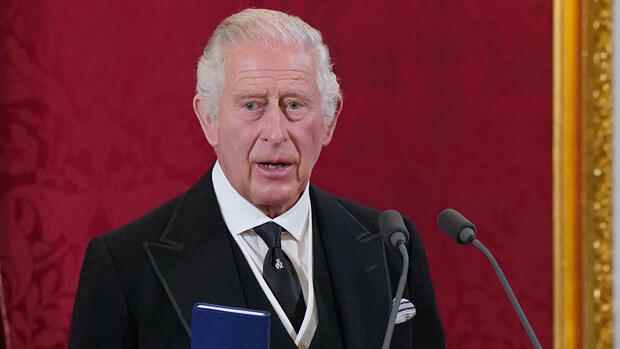King Charles III makes his statement during the Succession Congress at St James’s Palace in London.
(Photo: dpa)
London As the trumpeters position themselves on the balcony of St. James’s Palace, a murmur goes through the crowd. Thousands have come to witness the official start of their new monarch’s era. Two days after the death of his mother, Queen Elizabeth II, Charles III. was ceremonially proclaimed King of Britain in London.
Fanfare blasts and the presence of numerous soldiers with bearskin hats made the proclamation audible and visible to the people outside on Saturday. The proclamation had previously been carried out inside St. James’s Palace – not far from Buckingham Palace. It was a formal act: 73-year-old Charles had automatically become king with the death of his mother. The state funeral of the Queen, who died on Thursday, is scheduled for September 19, the palace announced.
“I am deeply aware of the great legacy and the duties and heavy responsibilities of the monarch that have now been entrusted to me,” said Charles III. on Saturday. The reign of his mother, who died on Thursday at the age of 96, was unsurpassed in length, devotion and devotion. He will endeavor to “follow the inspirational example that has been given to me in upholding the Constitution and in striving for peace, harmony and prosperity among the peoples of these islands, Commonwealth areas and territories around the world.”
Being there in person is important for many to understand that a new era is beginning here after the Queen had reigned for 70 years. Not all onlookers fit into the small street at St. James’s Palace.
Top jobs of the day
Find the best jobs now and
be notified by email.
When the proclamation was read, cheers broke out on the magnificent boulevard “The Mall” next door. “Long live the king,” it echoes across to the balcony.
For the proclamation, an Accession Council was specially convened, a “Council for the Accession to the Throne”, which includes members of the Privy Council – i.e. current and former government officials, church officials, judges, members of the royal family and other personalities.
Being there personally is important to many. Not all onlookers fit into the small street at St. James’s Palace
(Photo: dpa)
The king’s eldest son and new heir to the throne, Prince William (40), was the first to sign the proclamation – dressed in an elegant frock coat with a black tie. He was seen in public for the first time since the death of his grandmother at a formal appointment.
Then Charles’ wife, Queen Camilla (75), signed. Charles later said at the ceremony, “I am deeply encouraged in all of this by the continued support of my beloved wife.” Camilla became Queen Consort on the death of Queen Elizabeth II. The title was last given to the mother of the deceased monarch, Queen Mum.
William, hitherto officially the Duke of Cambridge, now has the title Prince of Wales, which is customary for the heir to the throne. Charles had already confirmed this in his speech to the British nation on Friday. William’s wife Kate (40) becomes Princess of Wales. William’s mother, Princess Diana, who died in a car accident in 1997, had last actively borne this title.
After the ceremony in and at St. James’s Palace in Westminster, Charles III. also proclaimed as the new king in the City of London. Guardsmen and thousands of onlookers gathered in front of the Royal Exchange, the site of the first stock exchange in London.
Members salute the Royal Exchange in the City of London after the proclamation of King Charles III’s accession to the throne. was read.
(Photo: dpa)
In a solemn procession, the Lord Mayor, who presides over the financial district, made his way from his seat known as the “Mansion House” to the Royal Exchange. Introduced by fanfare, a Herald read the proclamation. Then the national anthem was sung there with the new line “God Save the King”.
A coronation is also pending – the date for this has not yet been set. Elizabeth II’s coronation took place in 1953 – 16 months after she became queen after the death of her father.
The Queen died Thursday at her country home, Balmoral Castle, in Scotland. The body is to be transferred from there this Sunday to Holyrood Palace in Edinburgh, the Queen’s residence in Scotland. The body will then be laid out in a cathedral in the Scottish capital before being taken to London.
Charles approved an additional public holiday for the people of Britain. This could indicate that the Queen’s state funeral is due to take place on Monday 19 September. So far, September 18 has also been a possible date, but that’s a Sunday. An official confirmation of the date is still pending.
For Saturday Charles III. already have a busy schedule. According to Buckingham Palace, a total of four audiences were planned for the afternoon. First the King was to meet the Archbishop of Canterbury, then Prime Minister Liz Truss and ministers from her government, then representatives of the opposition and finally the Dean of Westminster.
The clergyman, David Michael Hoyle, has a special position as head of Westminster Abbey: the abbey has the status of “royal abbey”. The dean is not subordinate to the Archbishop of Canterbury, the spiritual head of the Church of England, but directly to the monarch.
At Buckingham Palace, the flow of mourners continued on Saturday. Thousands of people gathered early in the morning to lay flowers or cards, light candles or pause. So that the property does not sink under the sea of flowers, all bouquets are allowed to lie in front of it for twelve hours before they are taken to the adjacent Green Park.
More: Balance between tradition and change – After the death of the Queen, the British are looking for new stability
